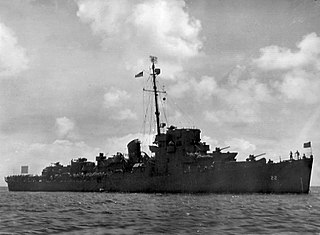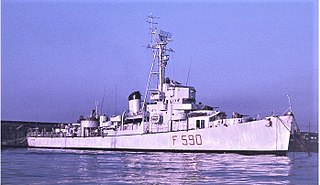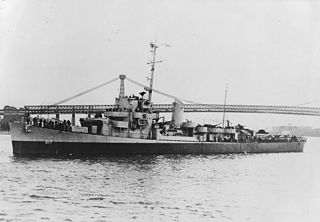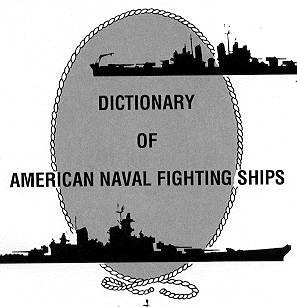 | |
| History | |
|---|---|
| Name: | USS Austin |
| Namesake: | John Arnold Austin |
| Laid down: | 14 March 1942 |
| Launched: | 25 September 1942 |
| Commissioned: | 13 February 1943 |
| Decommissioned: | 21 December 1945 |
| Struck: | 8 January 1946 |
| Fate: | Scrapped by the Terminal Island Naval Shipyard, 9 January 1947 |
| General characteristics | |
| Type: | Evarts-class destroyer escort |
| Displacement: |
|
| Length: | |
| Beam: | 35 ft 2 in (10.72 m) |
| Draft: | 11 ft (3.4 m) (max) |
| Propulsion: |
|
| Speed: | 21 knots (39 km/h; 24 mph) |
| Range: | 4,150 nmi (7,690 km) |
| Complement: | 15 officers and 183 enlisted |
| Armament: |
|
USS Austin (DE-15), was an Evarts-class destroyer escort of the United States Navy during World War II. The ship was named for Chief Carpenter John Arnold Austin (1905-1941) who was killed in action on board USS Oklahoma during the attack on Pearl Harbor by Japanese forces on 7 December 1941, and was posthumously awarded the Navy Cross.

The Evarts-class destroyer escorts were destroyer escorts launched in the United States in 1942–44. They served in World War II as convoy escorts and anti-submarine warfare ships. They were also known as the GMT or "short hull" DE class, with GMT standing for General Motors Tandem Diesel drive.

Destroyer escort (DE) was the United States Navy mid-20th-century classification for a 20-knot (23 mph) warship designed with endurance to escort mid-ocean convoys of merchant marine ships. Kaibōkan were designed for a similar role in the Imperial Japanese Navy. The Royal Navy and Commonwealth forces identified such warships as frigates, and that classification was widely accepted when the United States redesignated destroyer escorts as frigates (FF) in 1975. Destroyer escorts, frigates, and kaibōkan were mass-produced for World War II as a less expensive antisubmarine warfare alternative to fleet destroyers. Other similar warships include the 10 Kriegsmarine escort ships of the F-class and the two Amiral Murgescu-class vessels of the Romanian Navy.

The United States Navy (USN) is the naval warfare service branch of the United States Armed Forces and one of the seven uniformed services of the United States. It is the largest and most capable navy in the world and it has been estimated that in terms of tonnage of its active battle fleet alone, it is larger than the next 13 navies combined, which includes 11 U.S. allies or partner nations. with the highest combined battle fleet tonnage and the world's largest aircraft carrier fleet, with eleven in service, and two new carriers under construction. With 319,421 personnel on active duty and 99,616 in the Ready Reserve, the Navy is the third largest of the service branches. It has 282 deployable combat vessels and more than 3,700 operational aircraft as of March 2018, making it the second largest and second most powerful air force in the world.
Contents
The second Austin (DE-15) was laid down on 14 March 1942 at the Mare Island Navy Yard as HMS Blackwood (BDE-15) for the United Kingdom under the terms of the Lend-Lease Agreement; launched on 25 September 1942: sponsored by Mrs. W. C. Springer; taken over by the United States Navy on 25 January 1943 and redesignated DE-15; and commissioned on 13 February 1943, Lt. Comdr. H. G. Claudius, USNR, in command. The destroyer escort was apparently commissioned as simply DE-15 for the name Austin was not assigned to her until 19 February 1943, six days after she went into commission.

The United Kingdom, officially the United Kingdom of Great Britain and Northern Ireland but more commonly known as the UK or Britain, is a sovereign country lying off the north-western coast of the European mainland. The United Kingdom includes the island of Great Britain, the north-eastern part of the island of Ireland and many smaller islands. Northern Ireland is the only part of the United Kingdom that shares a land border with another sovereign state—the Republic of Ireland. Apart from this land border, the United Kingdom is surrounded by the Atlantic Ocean, with the North Sea to the east, the English Channel to the south and the Celtic Sea to the south-west, giving it the 12th-longest coastline in the world. The Irish Sea lies between Great Britain and Ireland. With an area of 242,500 square kilometres (93,600 sq mi), the United Kingdom is the 78th-largest sovereign state in the world. It is also the 22nd-most populous country, with an estimated 66.0 million inhabitants in 2017.
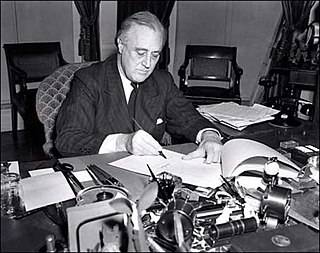
The Lend-Lease policy, formally titled An Act to Promote the Defense of the United States, was an American program to defeat Germany, Japan and Italy by distributing food, oil, and materiel between 1941 and August 1945. The aid went to the United Kingdom, China, and later the Soviet Union, Free France, and other Allied nations. It included warships and warplanes, along with other weaponry. The policy was signed into law on March 11, 1941, and ended overnight without prior warning when the war against Japan ended. The aid was free for all countries, although goods in transit when the program ended were charged for. Some transport ships were returned to the US after the war, but practically all the items sent out were used up or worthless in peacetime. In Reverse Lend Lease, the U.S. was given no-cost leases on army and naval bases in Allied territory during the war, as well as local supplies.














